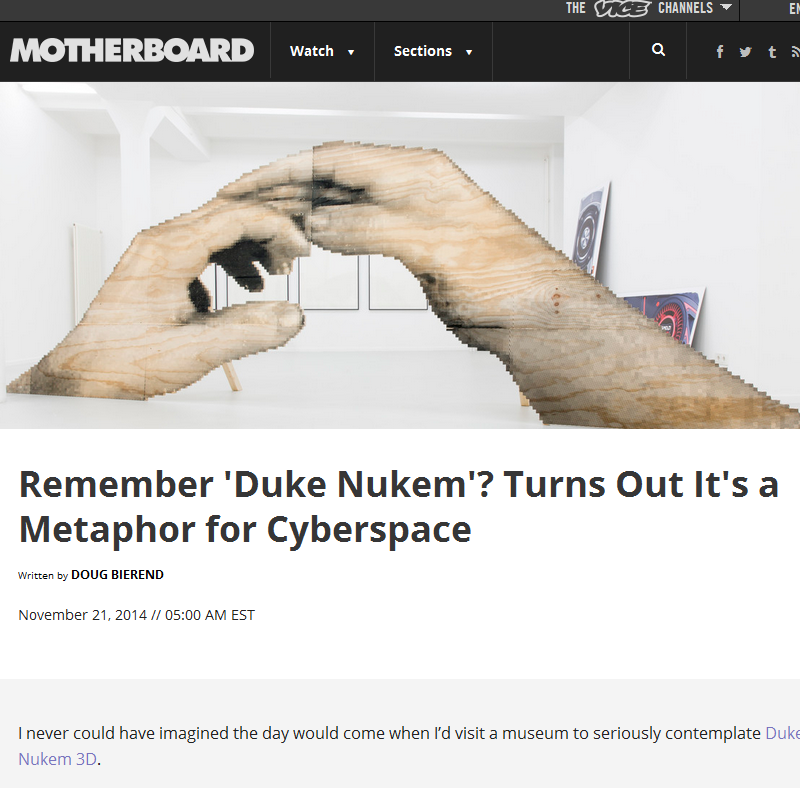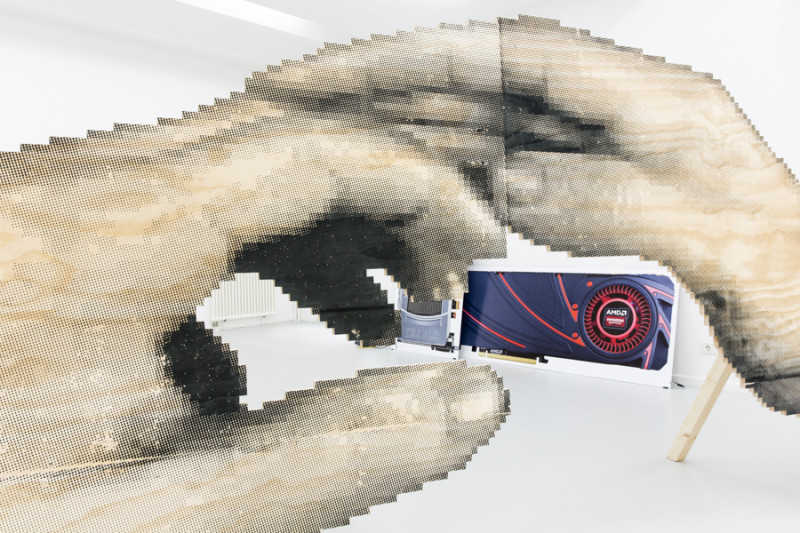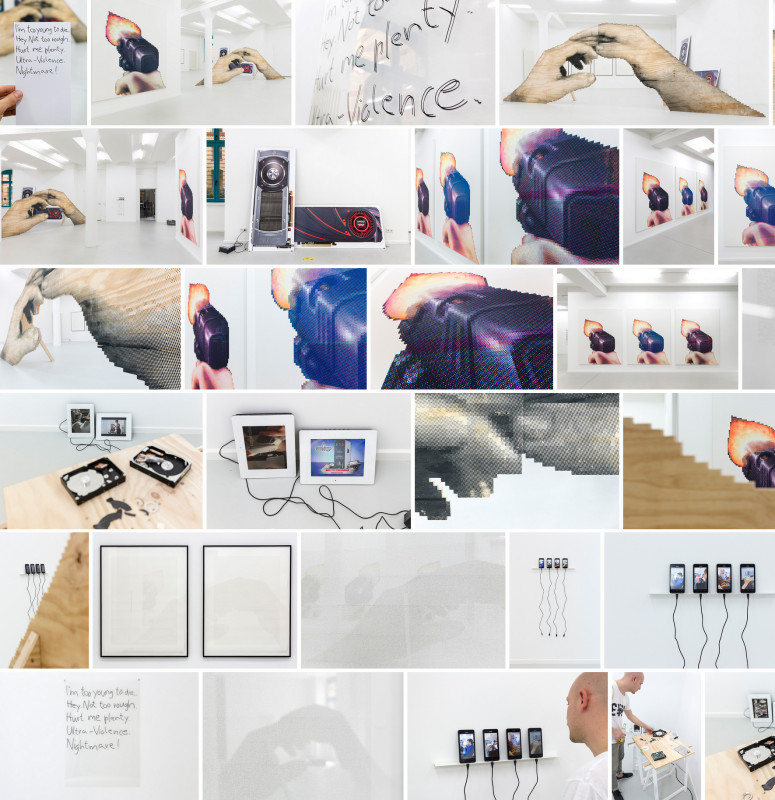Archive for the ‘hurtmeplenty’ tag
Hurt me plenty review – Motherboard
Review of Hurt me plenty on Motherboard Vice http://motherboard.vice.com/read/hurt-me-plenty
by Doug Berend
thx!!
Computer art of today
‘Hurt me plenty’ opening speech by Olia Lialina
Opening speech by Olia Lialin on Sept 12th 2014, DAM gallery Berlin.
Aram Bartholl – Hurt me plenty (pictures )
13th September – 1st November 2014
DAM Gallery, Berlin
Good evening,
I’m happy to have a chance to talk at the opening of Aram Bartholl’s, “Hurt me plenty” exhibition. Please allow me to start by mentioning another artist, Herbert Franke. His work was exhibited at the DAM Gallery many times I believe. Some year ago I invited him as a computer art pioneer to tell young designers about the origins of Algorithmic Art and Generative Graphics.
It was a very inspiring and energetic talk. One of the most thought provoking parts though was Franke explaining that there were times such as in the late 50’s/early 60’s when you had to fight for the idea that you can make Art with computers. Computer Artists were outcasts of the Fine Art scene. They couldn’t claim to be called Artists. It was just not accepted, because computers are algorithmic and Art is spiritual. Art was not allowed to come from computers or algorithms. These times are long gone. Digital computers became medium, then meta-medium, and turned in to new media. There is hardly any art today made without computers in Fine Arts and in Contemporary Art. Moreover, there is a whole universe of Media Arts with at least a 30 years old tradition of creating art with digital technology as being medium specific, not just by producing the work with some application, but with being critical or at least attentive to the software itself.
Today we find ourselves surrounded by post-digital and post-internet art, whereas renouncing of digital technology is so important and paying attention to the computer is supposed to be of ‘yesterday’. In post-digital art, hybrid forms are preferred and ambiguous, veiled messages are sent around. Like, common, digital is everywhere. Don’t even mention it. Be an Artist. Don’t be Computer Artist. Full circle.
In particular, this state of the arts makes me think about the possible revival of Computer Art as a notion and term that nowadays could belong to artists who make an effort to show the computer itself. It is neither algorithmic, nor nostalgic. Not 8 bit.
Art of direct messages and gestures. Clear and totally explicit.
Here are 10.000 passwords from Yahoo messenger. Find yours.
This is the graphic card. A computer inside your computer. It is expensive and powerful.
This is your phone. You have no idea when it is off or on. Come to a workshop and make a copper bag to put it inside and find out for sure.
This is the Hard Disk Crusher. This is your hard disk.
Computer art of today is hardware art. Art of hard messages. It hurts.
These brutally scratched hard disk plates are there. They refer to a significant case that happened a year ago when the Guardian received an order to destroy the computer where Snowden’s files were stored. In the mass media we saw explicit pictures of damaged computer parts and images of journalists executing drives and chips. It hurts to see it, hurts to listen to the Guardian’s Editor in Chief, who says, “Its harder to smash up a computer than you think”. Yeah, it’s even harder to accept it as a reality, journalists drilling though hard drives.
They were forced to do so. It was an act of intimidation. But, I think soon we’ll do it voluntarily and on a regular basis. There is less and less certainty of what you are doing with your computer on the level of software. There is hardly a proper way to save, and almost no way to delete by giving commands to the software. When you really would want to delete information, you’ll have to put your hard drive into the hole of this machine.
You are probably familiar with classic images of the first ever computer called ENIAC from 1945. It’s a computer the size of this space, and it is operated by many people who rewire or rebuild it for every new tasks. ENIAC was operated on the level of hardware, because there was no software. These images are from the remote past, but maybe, they are also of the nearest future.
Software is developed in a way that makes us helpless and desperate and there are less and less commands available. I don’t have an ‘undo’ available on my phone any more. So if something crucial, if I really need to ‘undo’, the only way is to throw my phone into this hole. I’m exaggerating. Whats this phone after all? This dumb terminal through which I connect to the Cloud? But the Cloud is in the same routine.
Earlier this year at the Transmediale Festival, Sebastian Schmieg and Johannes Osterhoff showed their project “10 kilograms from the Google factory”. It’s a box of shredded hard disks from the Google Data Center in Belgium with hundreds of useless, formless objects looking like fragments of a meteorite. It’s of no importance for Science, but could be well suited for the gift shop of a science museum. Artists were actually selling them as a souvenir – 85 Euros per piece. Buy part of the Cloud, say hello to your files.
But there is also good news. There is a computer artist who brings a hard disk ‘crasher’ in to the gallery. It looks small here. It is three times smaller than the graphic card on the wall. These cards will not fit inside there. The ‘crasher’ looks rather harmless here. Looks like there maybe alternatives. There is a future for software. That there is a chance for software transparency, a chance to delete by giving a command to the computers not the computer terminators. You should see clearly to think about it.
Dimensions and scale matter.
Last semester we had the honor of hosting Aram at the Merz Akademie. He made a project with my students titled, “For your eyes only”. It was about wearable smart objects: smart watches, smart glasses. These are technologies that promise to be very helpful and almost invisible. Week after week this group was doing the opposite, working on projects and objects that would bring awareness about the presence of the devices. Works that would made them visible and that would make us notice them. Two students decided to build a big model of Google Glass. Like really big. Three to two meters or something like this. Yeah, surprise, of course, invite the author of the monumental ‘Marker’ and ‘Dust’ to teach, and wonder that his students will search for some vivid element of the digital realm to erect a statue of in public space. I know that Aram was not really comfortable with this and tried to guide students into more subtle solutions, but they were steadfast in their decision. And in the end of the semester, they carried in a huge clumsy model of this trendy high-tech accessory. I don’t know what grade they got, but it still stays there, an unusable and sad object like Google Glass itself. But now you can clearly see it.
The thing is, we are not blind, but invisible computing made us longsighted, we don’t see what is right in front of our eyes because we are not supposed to see it. Computer Art can help. It has an optic.
Enjoy magnification, zoom in, clear images and binary statements.
Olia Lialina 2014
Olia Lialina
Net Artist, one of the net.art pioneers.
Co-founder of Geocities Research Institute
New Media Professor at Merz Akademie, Stuttgart
Hurt me plenty – Pictures & Press
All pictures: https://www.flickr.com/photos/bartholl/sets/72157647904042972/
Hurt me plenty
Exhibition: 13th September – 1st November 2014
DAM Gallery, Berlin
7:30: Introduction by Olia Lialina, Professorin New Media at the Merz Akademie Stuttgart.
In his solo show Aram Bartholl exhibits a new series of works inspired by the questions and developments engaging humankind’s ‘entry’ into the digital realm and the role of the first person as ‘shooter’. Bartholl deconstructs stereotypes about pixel imaging with unique large-scale works that are subtly combined with a series of pieces about issues of privacy, surveillance and net neutrality. With this exhibition, Bartholl proposes a new discourse that challenges the current debates about surveillance versus the seemingly antiquated ideas and images of ‘cyberspace’.
Press:
- Hurt me plenty – opening speech by Olia Lialina
- press release DAM gallery, by Tina Sauerländer PDF (PDF deutsch)
- http://motherboard.vice.com/read/hurt-me-plenty
- aqnb.com “Aram Bartholl, Hurt me plenty (2014)” by Jean Kay
- makezine.com ‘A First-Person Tour of Aram Bartholl’s First-Person Shooter Art Exhibition’ by Andrew Salomone
- Breitband Deutschlandradio, ‘Vorsicht Ironie’ by Moritz Metz (mp3, at 20:13 min)
- kotaku.com ‘Yes, Even Duke Nukem Is Art‘ by Luke Plunkett
‘
Individual Invitations
Hurt me plenty
Preview: September 12, 2014, 19 – 21 Uhr
September 13 – November 1st, 2014
DAM Gallery
Hurt me plenty
I’m pleased to announce my upcoming solo show at DAM gallery. New works!! CU there!!
Aram Bartholl – Hurt me plenty
Exhibition: 13th September – 1st November 2014
DAM Gallery, Berlin
Preview: 12th September 2014, 7 – 9 PM
7:30: Introduction by Olia Lialina, Professorin New Media at the Merz Akademie Stuttgart.
In his solo show Aram Bartholl exhibits a new series of works inspired by the questions and developments engaging humankind’s ‘entry’ into the digital realm and the role of the first person as ‘shooter’. Bartholl deconstructs stereotypes about pixel imaging with unique large-scale works that are subtly combined with a series of pieces about issues of privacy, surveillance and net neutrality. With this exhibition, Bartholl proposes a new discourse that challenges the current debates about surveillance versus the seemingly antiquated ideas and images of ‘cyberspace’.
Performance during the Preview:
BYOD – Bring Your Own Drive, and crush it.
Disused hard drives of PCs, laptops and servers imply a high security risk. DATALOVE prevents that discarded hard drives with sensible data fall into wrong hands. During the Preview of the exhibition the visitors are invited to bring their old data storage media and get them destroyed with a hardware crusher as part of Bartholl´s performance DATALOVE.
———————————————————————————————————-
Aram Bartholl – Hurt me plenty
Ausstellung: 13. September – 1. November 2014
DAM Gallery, Berlin
Preview: 12. September 2014, 19 – 21 Uhr
19:30: Einführung von Olia Lialina, Professorin New Media an der Merz Akademie Stuttgart.
In der Einzelausstellung zeigt Aram Bartholl eine Reihe neuer Arbeiten inspiriert von den Fragen rund um die Entstehung von First Person Skootern und dem ‘Eintritt’ des Menschen in das Digitale. Bartholl dekonstruiert mit großformatigen Arbeiten Pixelstereotypen und kombiniert diese auf subtile Weise mit den aktuell dringenden Themenkomplex rund um Privatsphäre, Überwachung und Neutralität im Netz. Die scheinbar antiquierten Ideen und Bilder von ‘Cyberspace’ versus der aktuellen Überwachungsdebatte werden in einer Ära der digitalen Omnipräsenz neu zur Diskussion gestellt.
Performance zur Eröffnung der Ausstellung:
BYOD – Bring Your Own Drive, and crush it.
Ausgediente Festplatten von PCs, Laptops und Servern bergen ein hohes Sicherheitsrisiko. DATALOVE verhindert, dass ausrangierte Festplatten-Laufwerke mit sensiblen Daten in falsche Hände geraten. Zur Ausstellungseröffnung sind die Besucher herzlich eingeladen im Rahmen von Bartholls Arbeit DATALOVE ihre alten Datenträger mitzubringen und vor Ort mit einem Hardware-Crusher zu zerstören.







